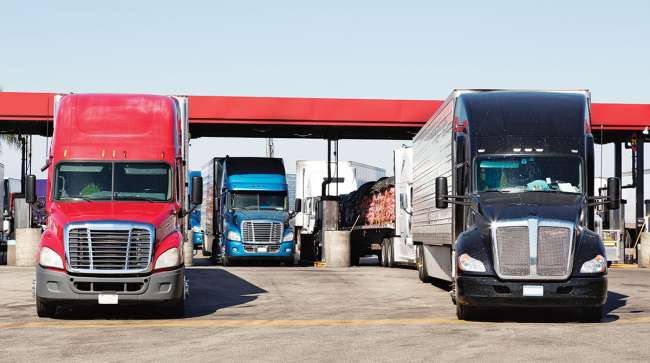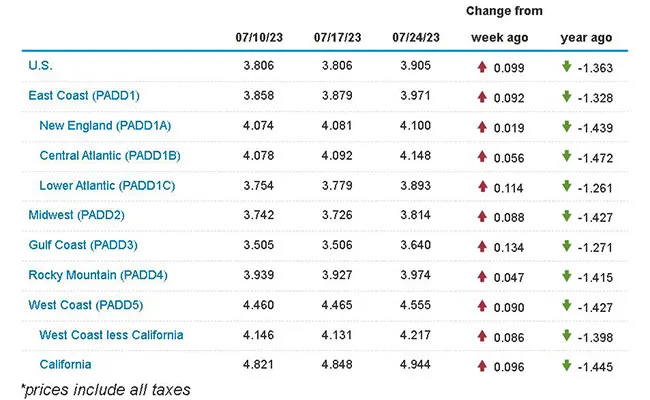Senior Reporter
Hefty Jump of 9.9¢ Pushes Diesel Price to $3.905 a Gallon

[Stay on top of transportation news: Get TTNews in your inbox.]
After a week of no fluctuation, on-highway diesel prices shot up a national average of 9.9 cents to hit $3.905 a gallon, according to Energy Information Administration data released July 24.
Diesel prices rose by the most on average since a 40.1-cent upswing March 14, 2022, to settle at $5.25 a gallon.
On July 17, the average diesel price remained unchanged ($3.806) for the first time since April 26, 2021.
A gallon of diesel on average costs $1.363 less than it did at this time in 2022.
The average diesel price went up in all 10 regions in EIA’s weekly survey, from a high of 13.4 cents in the Gulf Coast to a low of 1.9 cents in New England.
U.S. On-Highway Diesel Fuel Prices

EIA.gov
Meanwhile, gasoline increased 3.7 cents a gallon on average to reach $3.596.
In his July 24 blog, Patrick De Haan, head of petroleum analysis for GasBuddy, blamed some of the spike in fuel prices on the unrelenting heat that is impacting a large part of the country, especially the Southwest. He said that if the heat wave continues into August, it could have a profound impact on fuel supplies and prices later this summer.

De Haan
“For the second straight week, we saw another small rise in the national average, which has been stuck in the same 10-cent range we’re in today since April. It’s been a remarkably quiet summer for gas prices, which have been far less active than normal,” De Haan said. “However, with tremendous heat gripping much of the country, I remain concerned about the fuel that such high temperatures will provide for tropical systems that venture into the Atlantic and Caribbean.
“For now, I don’t expect much change in the toss-up that has been gas prices for weeks on end. But, with gasoline demand now hitting its summer high, there remain some risks that could disturb gas prices in a significant way before summer’s end.”
De Haan added that because Saudi Arabia is continuing to tighten oil production, and with the U.S. Strategic Petroleum Reserve releases now over, there could be a continued tightness in markets, pushing oil prices higher, perhaps past $80 per barrel.

Flynn
Worldwide oil prices have been climbing for the past month and closed the trading day July 24 at $78.95 a barrel, up from $74.15 just a week ago but down substantially from $94.70 last July 24.
Oil analyst Phil Flynn told Transport Topics he sees prices inching up over the next several weeks.
“Obviously, diesel was on fire again with the jump,” he said. “We kind of declared mission accomplished on heavy fuels last year because we had a warm winter, and Russia was able to export a lot of oil, and the acute shortages we feared were not as tight.
“Now the diesel markets are tightening and just when you thought it was safe to go back to the gasoline pump, now many people are saying not so fast. Demand for gasoline is strong, and I think we’re going to see them go up. I do see a bump here on prices, on both gasoline and diesel.”

How effective have third-party services proved to be for fleets? Let's find out with Michael Precia of Fleetworthy Solutions and Dan Rutherford with Summit Virtual CFO by Anders. Tune in above or by going to RoadSigns.ttnews.com.
But a key metric of the U.S. fuel market, the nation’s refining capacity, is showing signs of improvement, according to EIA’s latest report.
Refining capacity has reversed two years of declines and climbed by more than 100,000 barrels, to 18.1 million barrels per day. However, this figure still is below the pre-COVID capacity peak of 18.98 million barrels per day from 2019.
But the report does not include refining capacity expansion of 250,000 barrels per day that was added to the nation’s refining network after EIA concluded its research. Exxon Mobil’s Beaumont, Texas, refinery expansion went online in March, and it is the largest addition to a U.S. refinery in more than a decade. That increase pushed the nation’s total to about 18.3 million barrels per day of capacity.
“The markets are expecting right now that demand is going to exceed supply and the energy companies are keeping the refineries running to meet demand,” Flynn said.
U.S. average retail prices for July 24, 2023:
Regular grade #gasoline: $3.60/gal
On-highway #diesel: $3.91/gal#gaspriceshttps://t.co/dsfxiPA8Wj — EIA (@EIAgov) July 24, 2023
According to EIA, refinery capacity last week hit its second-highest level of the year as those facilities were operating at 94.3% of capacity and only slightly lower than the July 2 peak of 95.2%.
For most of the spring, refineries have been running in the low-90% range, but that has picked up recently as demand for petroleum products notched up.
Meanwhile, even as the weekly Baker-Hughes oil rig count shows an 11% year-over-year decline from 758 to 669 last week, domestic oil production in the U.S. continues to trend upward. Last week was at 12.6 million barrels per day, just 385,000 barrels from the all-time record of 13 million achieved in November 2019, about four months before the onset of COVID-19.
Want more news? Listen to today's daily briefing below or go here for more info:




